Best Brake Systems 401: Bigger Calipers Clamp Speed
By Richard Fong
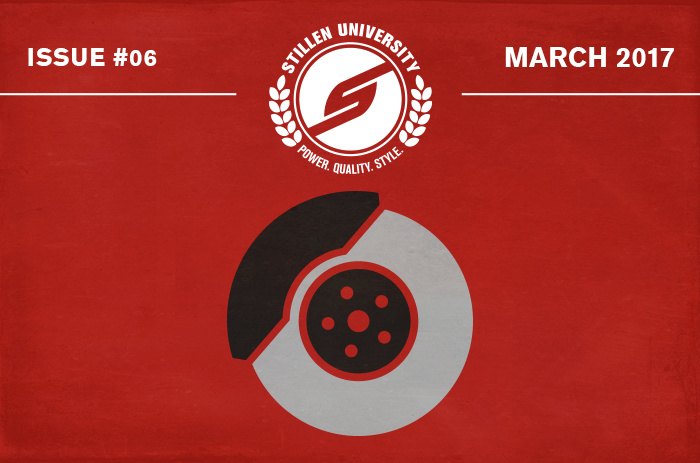
It’s no secret that brakes serve an important role from the standpoint of both performance as well as safety. After all, the typical street vehicle (cars, motorcycles, etc.) generates approximately 80-percent of stopping power from its front brakes. In Brake Systems 101, we covered some of the basics of braking, focusing on pads and rotors. Brake Systems 201 put emphasis on two-piece rotors as well as stainless-steel braided lines and higher performance brake fluids. The third installment, Brake Systems 301, introduced one component of the Big Brake System, larger rotors, which increases the heat capacity and friction surface area relative to stock. Now we’re going to look at the visual and functional star of the big brake kit, the brake caliper.
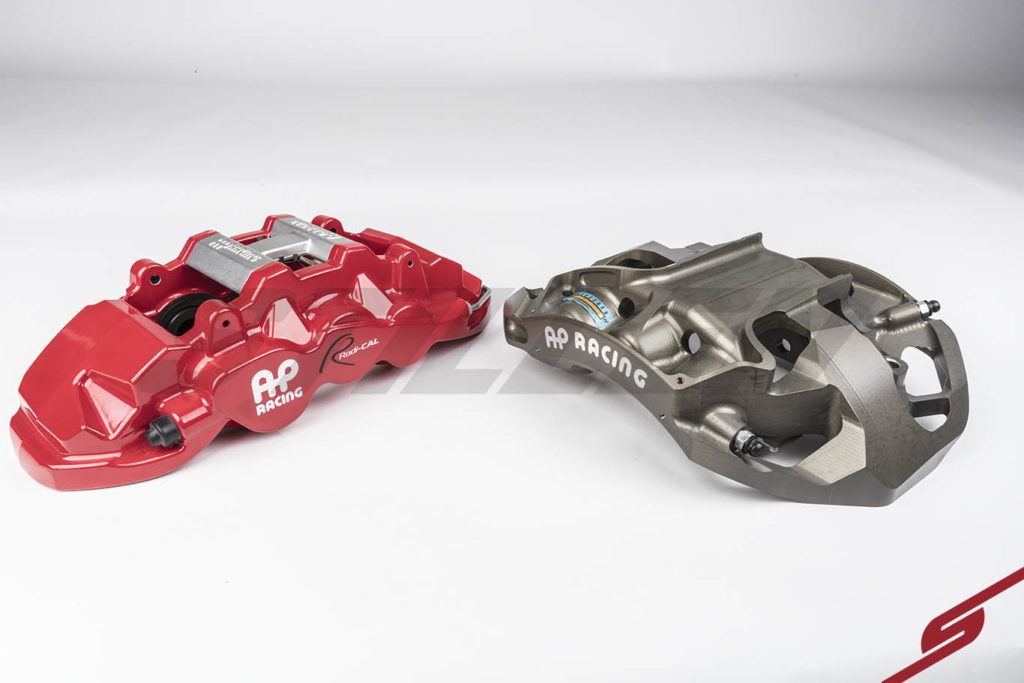
Applying Pressure
Brake calipers serve one purpose, to squeeze the pads against the rotor to generate friction, shave speed and eventually bring the vehicle to a stop. Calipers come in a variety of types, configurations and sizes. One of the most common factory caliper types is the sliding caliper, where one or more pistons press against the inboard brake pad, while the brake caliper housing slides inward, pulling on the outer pad to equalize the pressure to both sides of the rotor. Automakers often favor this type of caliper for its low cost and satisfactory stopping performance on the street. Unfortunately, these calipers suffer from excessive deflection under performance conditions and contribute to less than ideal braking performance. By contrast, fixed or opposed calipers, as the name implies, do not slide or move. There are an equal number of pistons that press on the pads isometrically to ensure equal pressure is applied to both sides for even wear.
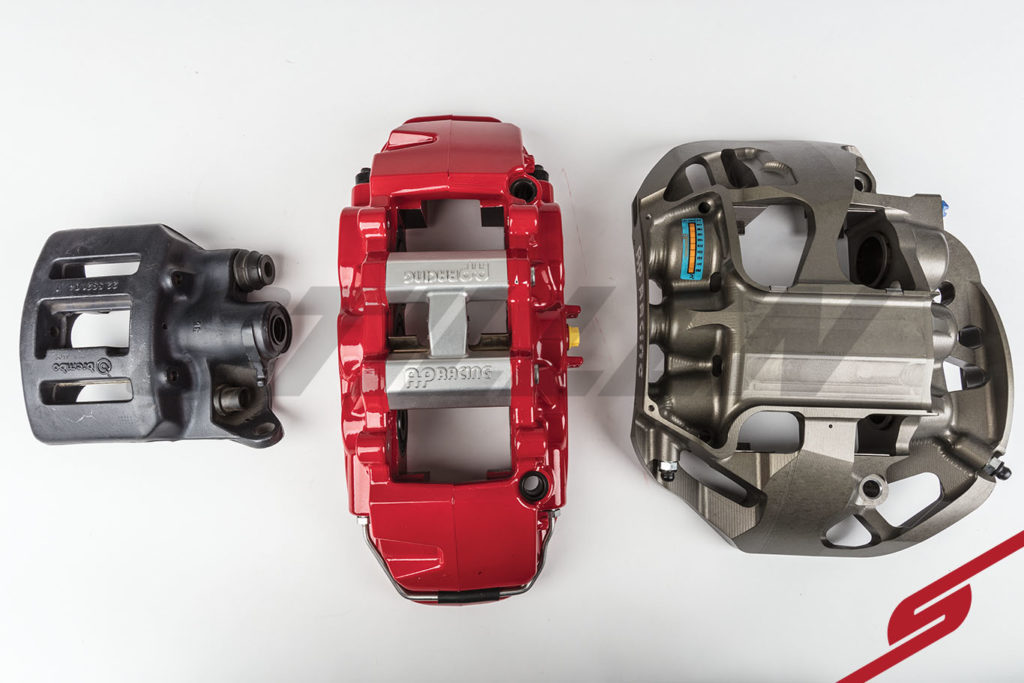
Bigger Rotors, Bigger Calipers
Increasing the heat capacity and the friction surface area by way of larger rotors prompts the use of correspondingly larger calipers. Upgrading to larger brake calipers and the use of larger brake pads make best use of the increased area availed by larger rotors for improved stopping performance. Larger calipers also tend to employ multiple pistons to ensure even application of pressure to the backing plate of the larger pads as they generate friction with the rotor surface.
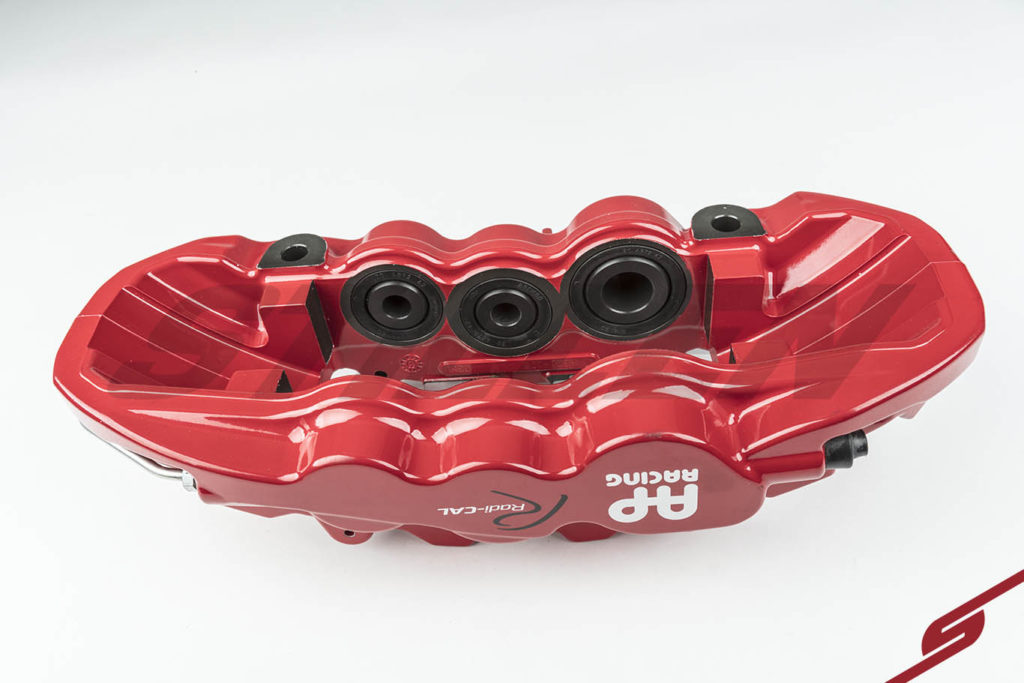
Pumped Up Pistons
The number and size of the pistons that a caliper employs is typically an indicator of the size of the calipers, pads and rotors. As rotors and pads get larger, so do the size of the calipers necessary to make use of the available friction surface. In order to evenly apply pressure to all of the available friction surface area, it becomes necessary to increase the number of pistons pressing on the pads. Sliding calipers employ a single, dual or even triple piston configuration, while fixed calipers feature an even number of pistons in an opposed configuration (pressing toward each other.)
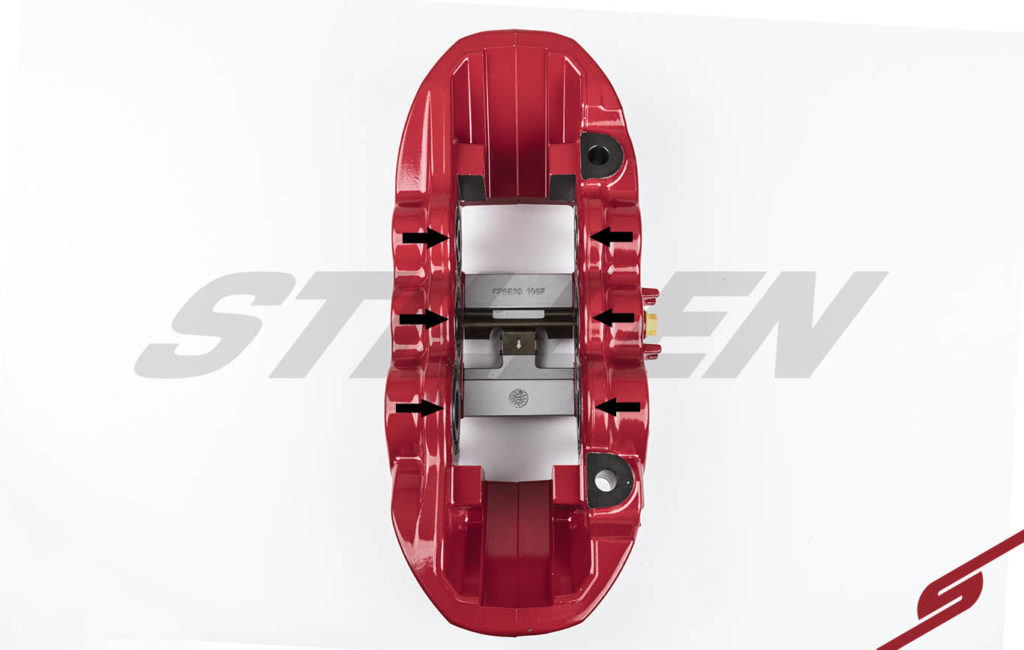
In an opposed, multi-piston caliper, the caliper body stays in a fixed location while the hydraulic fluid builds pressure behind the pistons and forces them to squeeze the pads to the rotor surface.
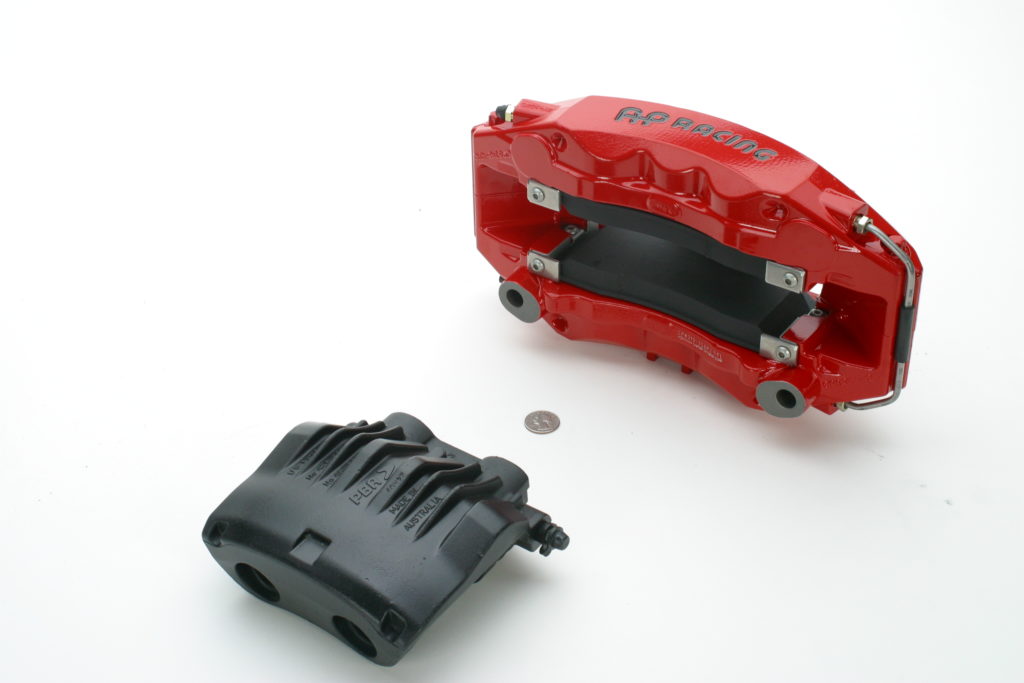
Cast, Forged, One Piece, Two Piece
Calipers are not only defined by their size but also their construction. Calipers are included among the components of unsprung weight and are subjected to a variety of conditions such as extreme temperatures and pressures. Thus, caliper design must take several variables into consideration.
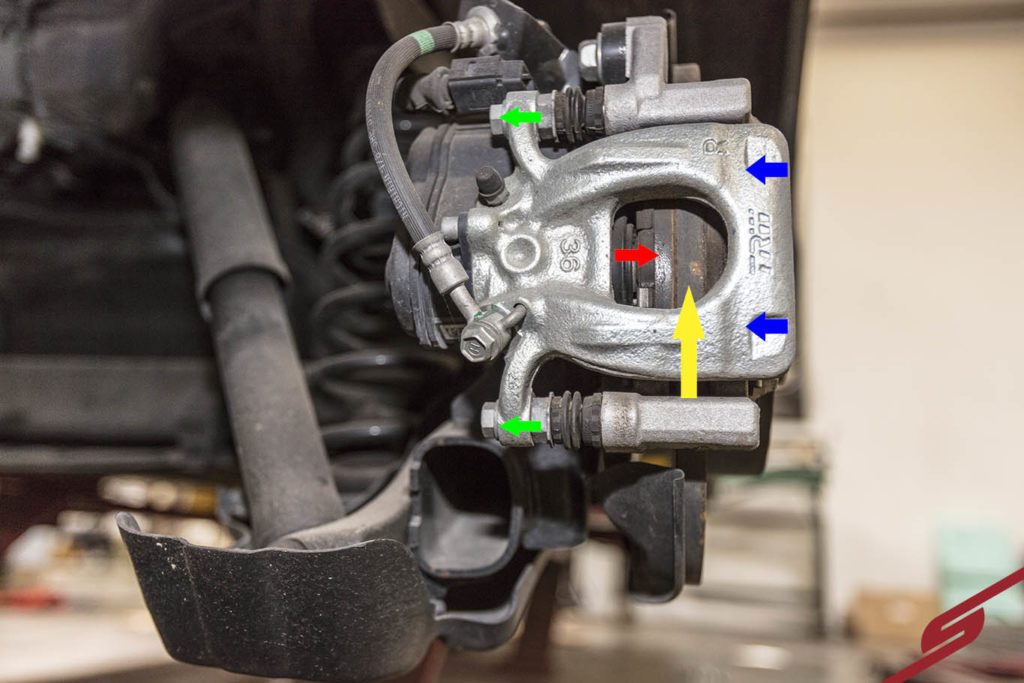
In the case of a single piston sliding caliper, the piston (red arrow) pushes on the inboard brake pad onto the rotor. The caliper body moves the opposite direction from the piston (green arrows) and pulls the outboard brake pad (blue arrows) onto the rotor surface.
The least sophisticated is the cast sliding caliper. Sliding calipers strike a balance of cost, weight and performance for the average streetcar. However, these calipers suffer from deflection and inadequate pressure under performance conditions, resulting in less than satisfactory results: Best Brake Systems 401: Bigger Calipers Clamp Speed.
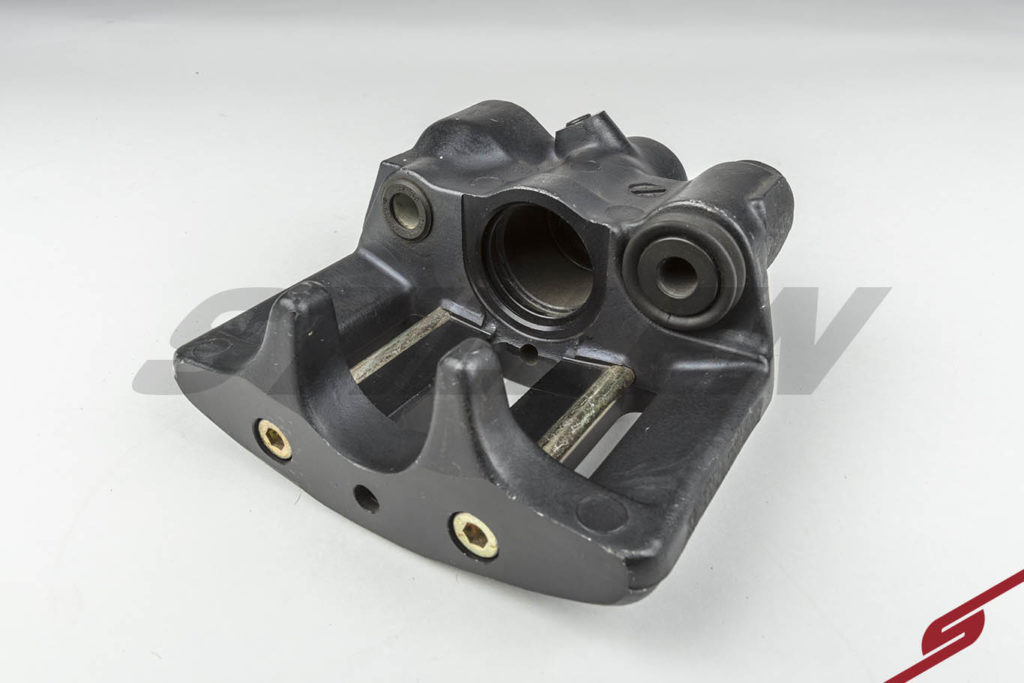
The cast two-piece caliper features an opposed piston configuration that resists deflection while offering improved application of pressure to the brake pads. An even stiffer solution is the forged two-piece caliper. This fixed caliper shares similar design traits to its cast cousin, but benefits from being forged for greater strength and stiffness.
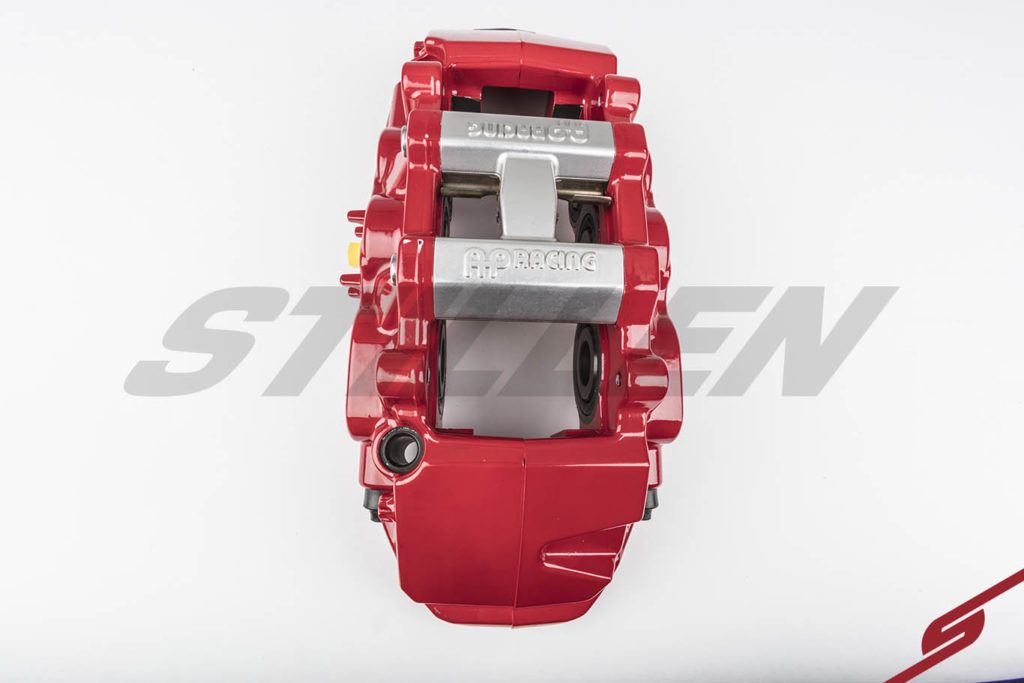
The stiffest and lightest solution, which also happens to be the most expensive, is the fixed, forged one-piece monoblock caliper. These tend to be machined from a forging of aluminum for strength and light weight. While offering the greatest performance, the cost to manufacture this type of brake caliper becomes cost prohibitive for all but the most well-funded of individuals or teams.
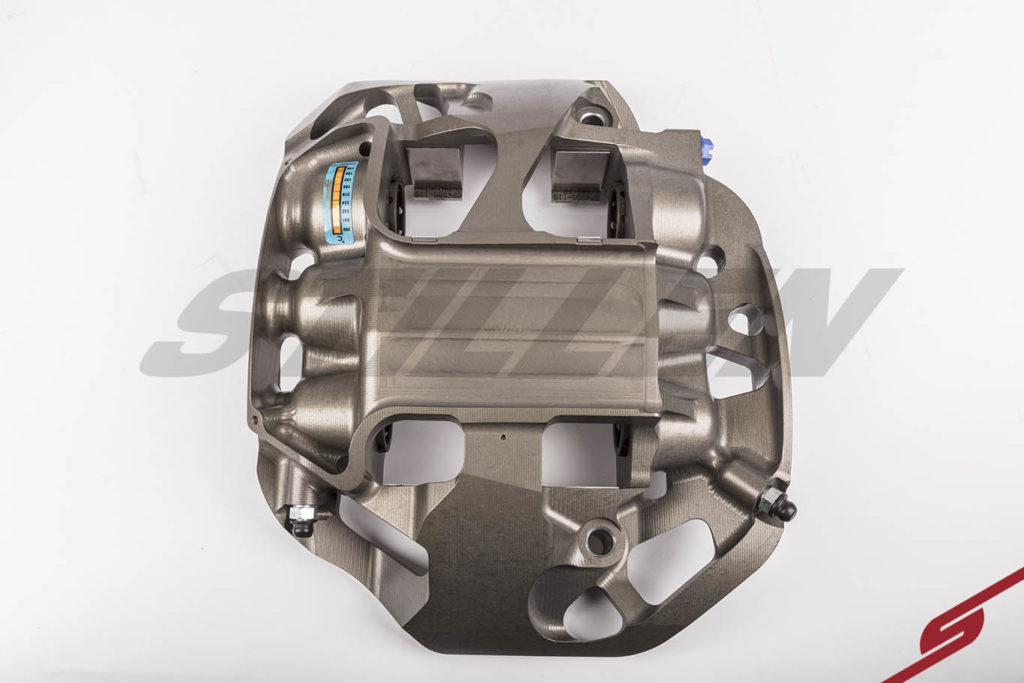
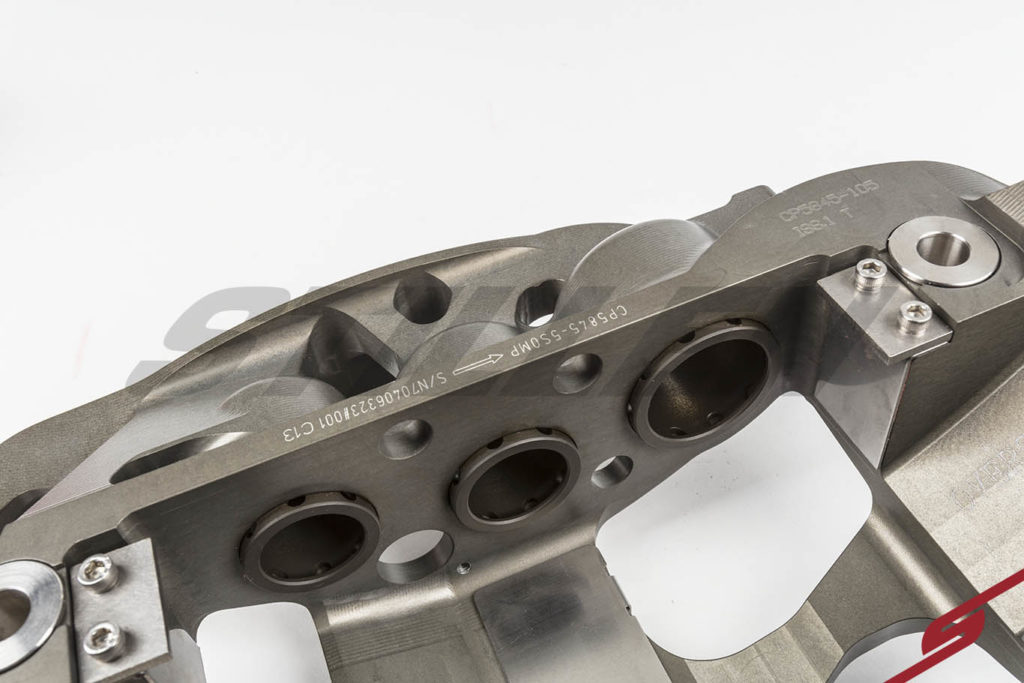
Racing calipers are massive, stiff and look really cool. But they’re not for street use. Racing calipers must be rebuilt on a regular basis throughout the racing season. As you can see, they do not have dust boots covering the pistons. This could lead to failure if debris or other contaminants damage the seals. Street calipers do not require the same maintenance schedule as racing applications, making them ideal for street driven vehicles.
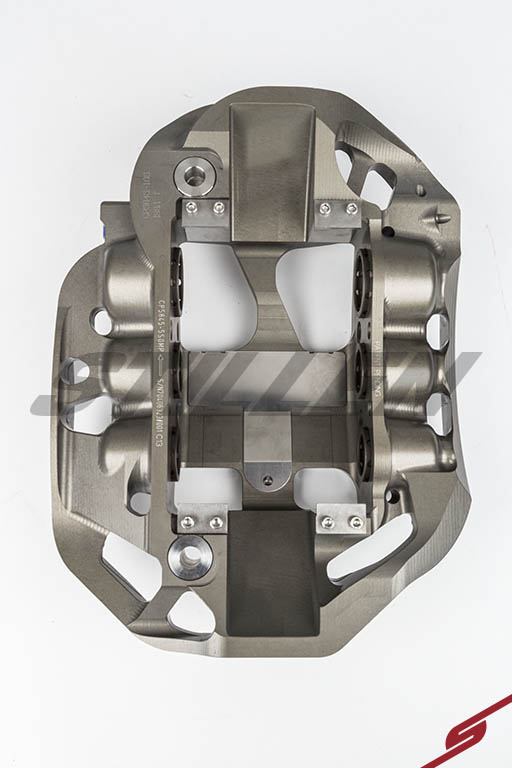
Piston Power
As mentioned earlier, calipers feature a greater number of pistons based on the size of the pads and the rotor. When increasing the pad and rotor size, applying equal pressure across the entire pad surface becomes essential for even application of pressure for optimal generation of friction. This can be achieved (up to a point) by way of larger pistons. When the caliper design calls for a lower profile to fit within the barrel of certain wheel sizes, adequate pad coverage can also be accomplished by way of additional pistons. Typical multi-piston configurations can range from four to six pistons with some designs employing up to as many as twelve pistons.
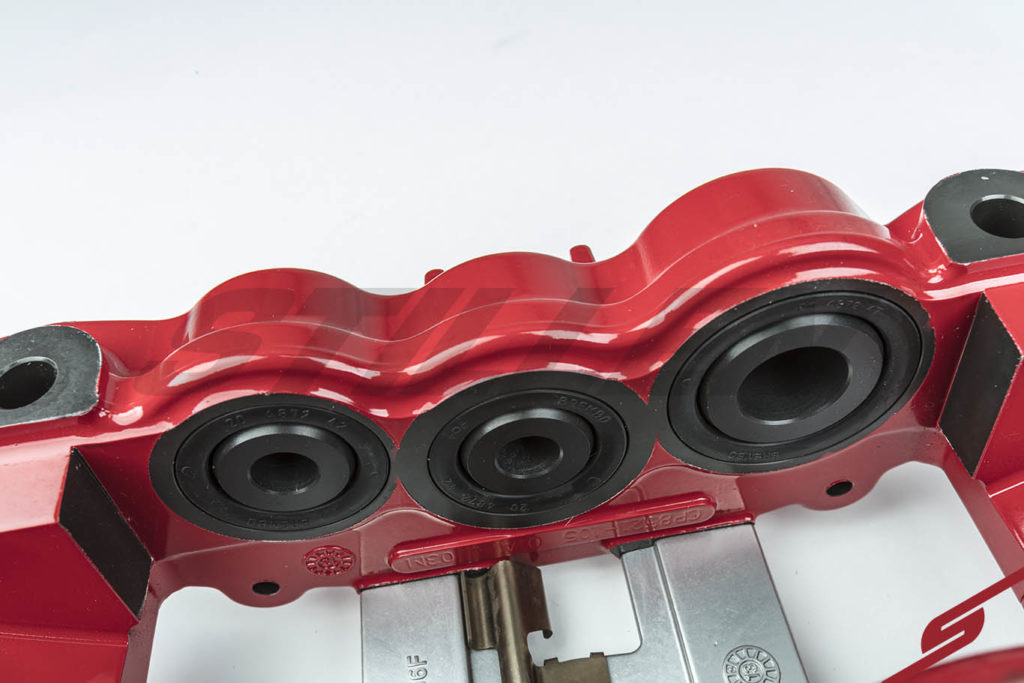
Bigger isn’t always Better
So, when four is good, six is better and twelve is fantastic, right? Not necessarily so. Optimizing your brake system depends on a myriad of variables, including purpose, vehicle weight and power output, to name a few. There is such a thing as overkill, and overkill on brakes could actually compromise other aspects of performance like handling and feel. Brakes fall under the category of unsprung weight, which has a direct effect on responsiveness and overall feel. This is why a smaller and lighter vehicle like a first generation (NA) Mazda Miata that weighs in at just over 2,000 pounds would not benefit from the massive factory six-piston, forged monoblock brakes engineered for the 3,800 pound Nissan R35 GT-R. Not only would the Miata have to run much larger wheels just to fit this brake system, it would be far too much brake for the fly-weight Miata. The nimble feel of the NA would also be lost due to unsprung weight gained at each corner. Conversely, the much heavier R35 GT-R would brake as if it were in the vacuum of space while trying to stop with the NA Miata’s diminutive braking system. Exaggerated examples aside, a properly sized brake upgrade can lend greatly to vehicle performance. The right combination can improve feel, heat capacity and longevity while mitigating detrimental side effects related to unsprung weight. Ultimately, the right brake system upgrade for your ride will complement the overall build as well as its appearance.
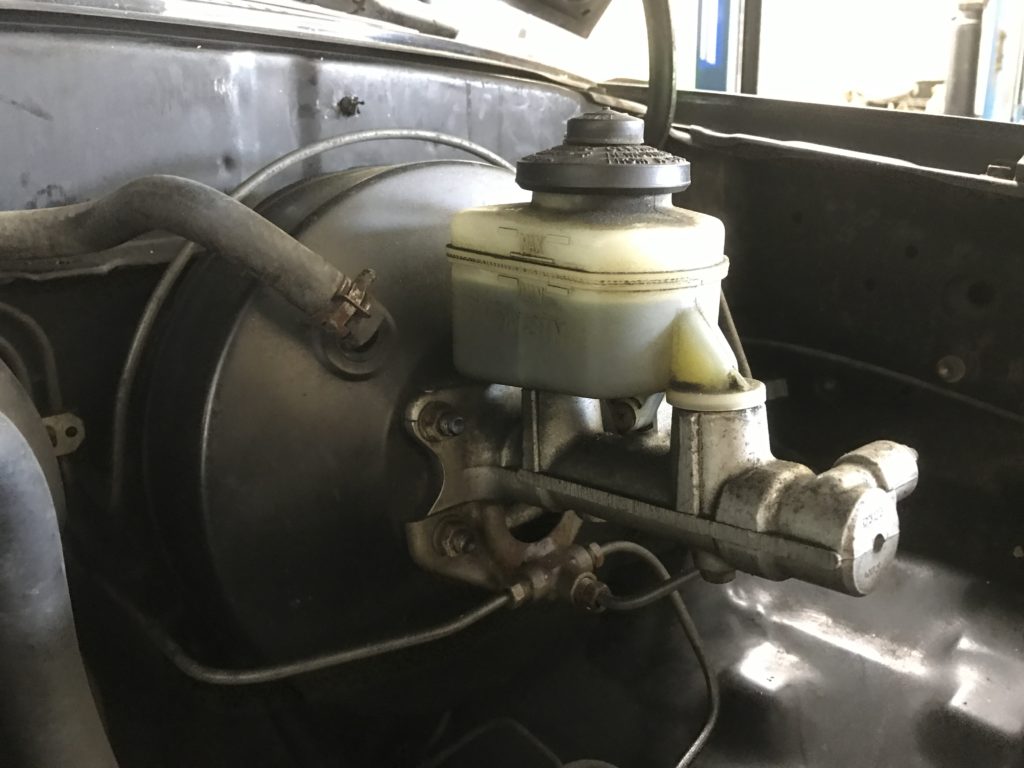
Sized Up: Brake Master Cylinder
Brake systems function on the mechanics of hydraulics, which is the use of fluid to perform mechanical force. In this case, the movement of the piston(s) in the calipers to apply pressure to the brake pads by displacing the pistons with brake fluid. The brake master cylinder forces fluid through the brake lines to each caliper to apply pressure to the pads. Since the amount of fluid displaced depends on the size and number of pistons, properly sizing the brake system includes evaluating the size of the brake master cylinder. When upgrading to a larger brake system, it is necessary to measure the displacement of the system to ensure that the brake master cylinder displaces enough fluid to deploy the pistons to press the pads against the rotor surface. Small bore brake master cylinders produce high pressure, while larger bore master cylinders deliver more volume.
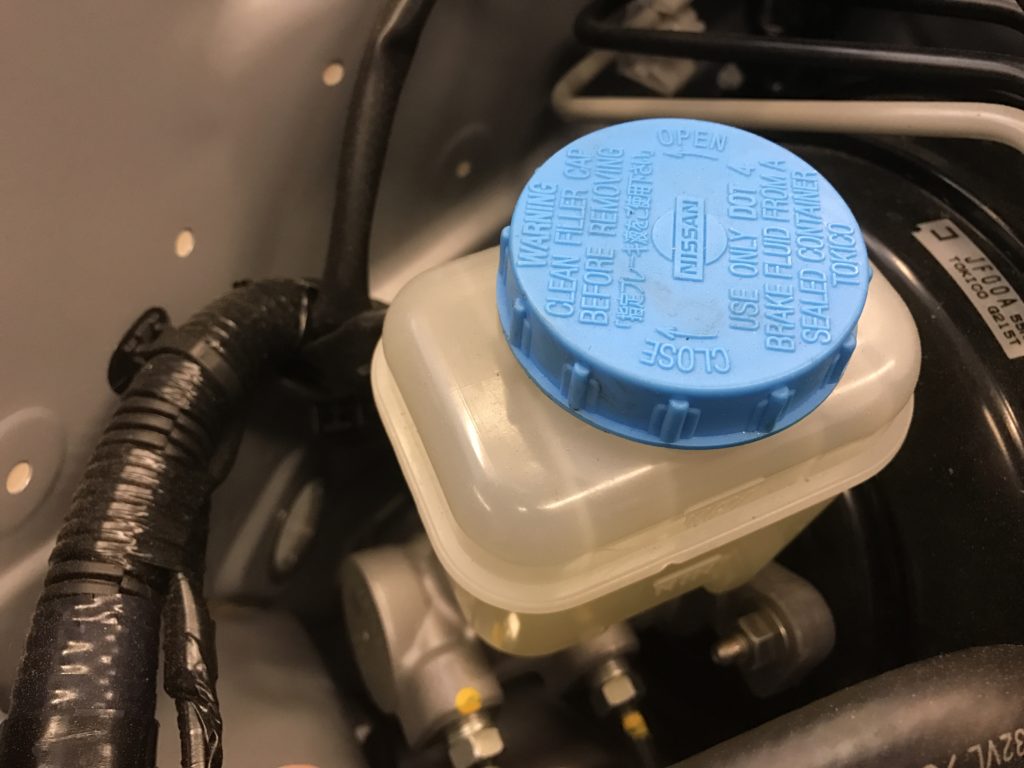
Automakers go to painstaking lengths to properly size the brake master cylinder to the brake calipers they equip the vehicles with to ensure a balance of pedal feel and brake system performance. Properly sized, bolt-on brake systems should be designed to work with the factory master cylinder. If upgrading to significantly larger brakes, it is sometimes necessary to increase the size of the brake master cylinder to ensure that the feel and performance is not thrown out of balance.
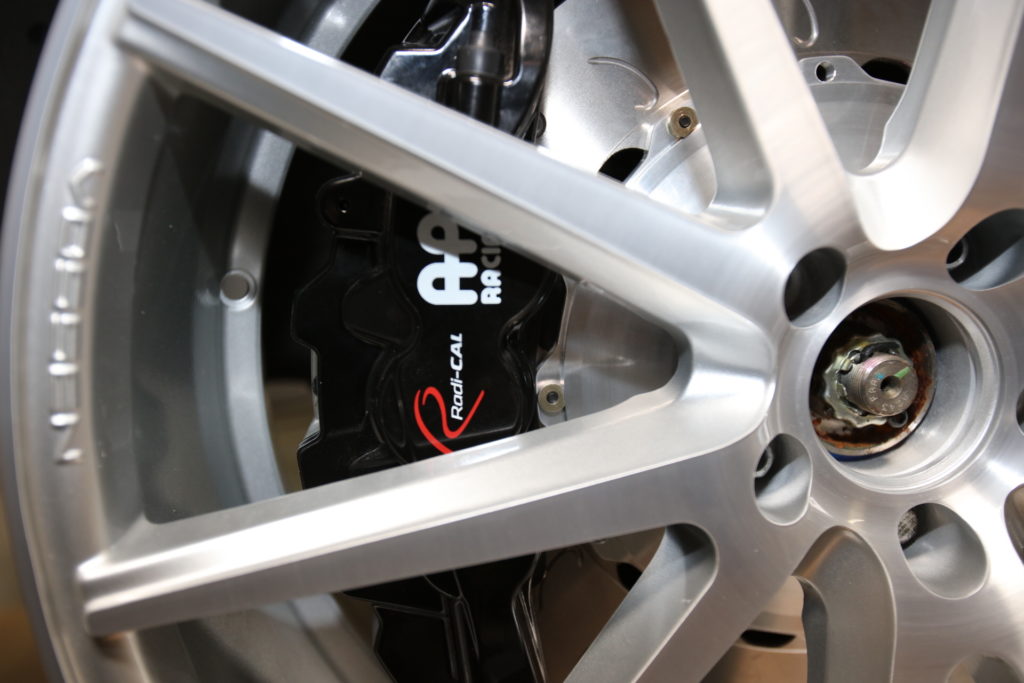
Science of Stopping
Properly-engineered brake system improvements ranging from the most basic pad and rotor upgrades to full Big Brake Kits will enhance the feel from behind the wheel while delivering longer sessions on twisty highways or quicker lap times. While horsepower will make your car faster, balancing that horsepower out with improved braking performance will help you navigate the streets and the track safely and, in record time.
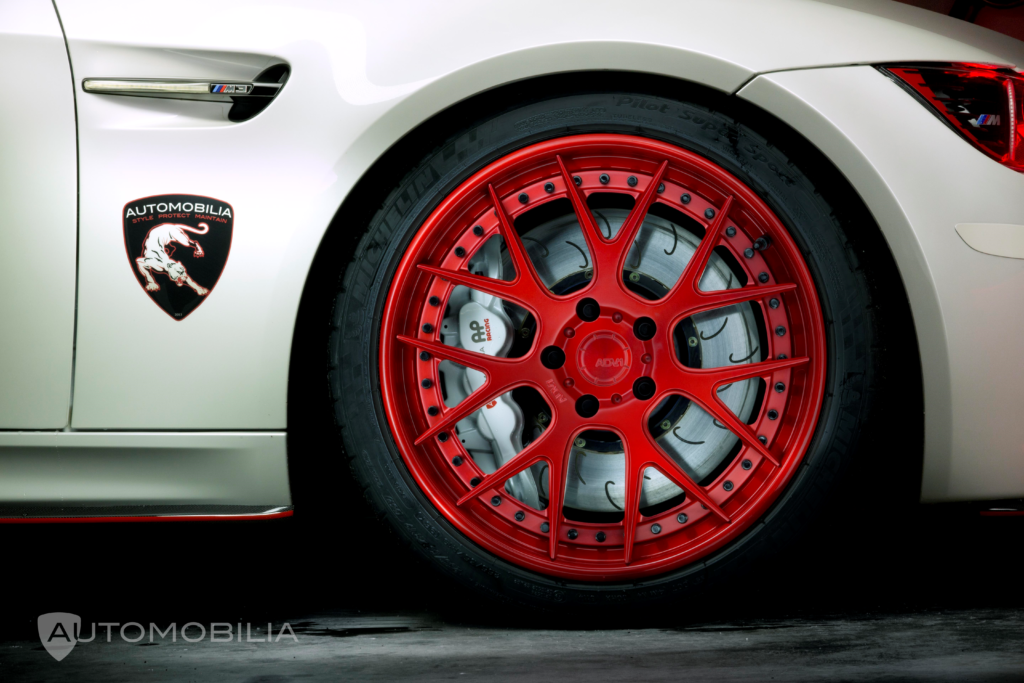
Find out what STILLEN has to offer to improve your brake system! Check out www.stillen.com and click through to the brake section.
Best Brake Systems 401: Bigger Calipers Clamp Speed
Got questions or ready to upgrade your brake system? Reach out to STILLEN at 866-250-5542, by email at sales@stillen.com, or via Live Chat at stillen.com!

